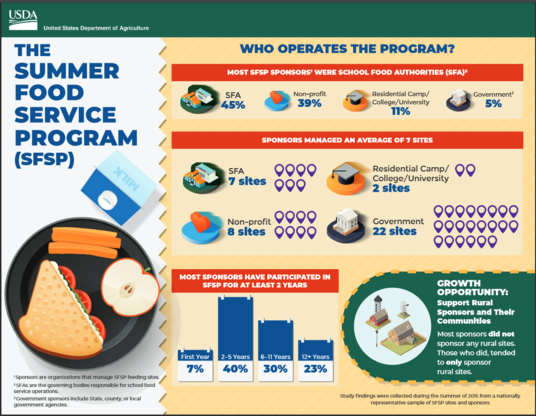|
The 2019 Farm to School Census is Happening Now!
It’s fall and schools nationwide are now back in session. Heading back to school is always an exciting time for kids and school staff alike, and this year is especially exciting as the USDA Food and Nutrition Service has launched its third Farm to School Census. This unique survey is out and in the hands of more than 18,000 School Food Authorities (SFAs)! FNS is counting on all SFAs to complete these surveys so that we can share the progress of these activities across the country. We want your hard work to be counted!
In the 2015 Farm to School Census, we learned that in the 2013-2014 school year:
- SFAs purchased almost $800 million in local food from farmers, ranchers, fishers, food processors and manufacturers.
- Of the respondents surveyed, 42 percent, comprising more than 42,000 schools, were bringing farm to school relevant activities to the cafeteria and classroom, with some farm to school activity taking place in every State across the country.
- School gardens are blooming, with 7,100 school gardens providing fresh fruits and vegetables to students in the classroom and in the lunch-line.
These are considerable accomplishments and FNS is looking forward to showing how much further schools have come since the 2015 Farm to School Census. Please help us show that farm to school is continuing to grow! If you are with an SFA, please make sure that you complete your Farm to School Census survey as soon as possible. If you are working in a school and doing important farm to school related work, make sure that you share that information with your local SFA director.
For more resources and information on this fall’s Farm to School Census effort, visit the Community Food Systems Farm to School Census Resources page here.
A Note from Julie Brewer, Director of the Office of Community Food Systems
Greetings! I am so excited to be joining the Office of Community Food Systems (OCFS)! I started my career over 25 years ago, with a passion for nutrition and ending hunger. In my early work, I helped my hometown, and several other communities in my home state of Montana, asses our community food systems and build projects to fill the gaps. Of course, this work led to discussions about sustainable agriculture and projects aimed at expanding access to local food. Over the years, my path led me to nutrition policy work at the local, state, and national level. I’ve had the privilege of participating in the implementation of historic changes to our safety net and nutrition programs; from welfare reform in the mid-90s, to the implementation of the Healthy, Hunger-Free Kids Act, I am keenly aware of the critical importance of thoughtful, engaged, and innovative leaders in communities, working to make change. That is why my excitement for this new role runs so deep.
Over the past several weeks, I have gotten to know the OCFS team and many of our grantees and collaborating partners. I’m so impressed and energized by the amazing talent and quality work that is happening in Farm to School today. Thank you for your part in this, and thanks to all who have welcomed me to this work and this team. I look forward to helping you advance this mission in your communities and witnessing your accomplishments and impact.
|
|
 |
Summer Food Service Makes a Difference and It Shows
Even with school back in session, it is never too late to consider how kids are able to access healthy and nutritious meals during the summer months. New materials produced by the FNS Office of Policy Support show the significance of feeding children when school is out of session.
The USDA Food and Nutrition Service completed its study of the Summer Food Service Program (SFSP) and posted a fact sheet that provides a number of insightful facts about SFSP activity.
Did you know…
- The largest group of SFSP sponsors are School Food Authorities (SFAs) followed by Non-Profit organizations. SFAs comprise 45 percent of SFSP operators while another 39 percent are Non-Profits.
- Sponsors of SFSP manage, on average, seven feeding sites.
- There is still room for growth with one out of every five SFSP sites served only lunch. More expansion can be done in breakfast or snack service for children during the summer months.
- Finally, SFSP sites served up to 900 children per day!
You can find these facts, and more about SFSP characteristics, online here.

Call for Proposals: 10th National Farm to Cafeteria Conference
The 10th National Farm to Cafeteria Conference in coming to Albuquerque, NM, April 21-23, 2020! Hosted by the National Farm to School Network, this biennial event will convene nearly 1,000 diverse stakeholders working to source local food for institutional cafeterias and foster a culture of food and agricultural literacy across America.
Do you have expertise to share? Conference organizers are seeking workshop and poster proposals from individuals and organizations working to improve our food system, strengthen community health, empower youth, advance equity and increase opportunities for farmers and food producers. The Request for Proposals (RFP) is open now through Oct. 4, 2019.
Chef Ann Foundation Looks to “Get Schools Cooking”!
The Chef Ann Foundation is a national non-profit that helps schools ensure that every child can access to fresh, healthy food. Their newest “Get Schools Cooking” initiative is a 3 year assessment and strategic planning program providing schools the operational knowledge to move from “heat and serve” to a “from scratch” cooking operational model.
Chef Ann Foundation’s is now accepting applications for Get Schools Cooking through Oct. 28. This is a great opportunity for school districts ready to make the transition to a scratch cook program. Apply today and learn more about this program here.
|